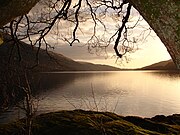Ecosystems
All forms of life interact with the environment in which they exist, and also with other life forms. In the 20th century this premise gave rise to the concept of ecosystems, which can be defined as any situation where there is interaction between organisms and their environment.
Ecosystems are composed of a variety of abiotic and biotic components that function in an interrelated way.[55] The structure and composition is determined by various environmental factors that are interrelated. Variations of these factors will initiate dynamic modifications to the ecosystem. Some of the more important components are: soil, atmosphere, radiation from the sun, water, and living organisms.
Each living organism has a continual relationship with every other element that makes up its environment. Within the ecosystem, species are connected and dependent upon one another in the food chain, and exchange energy and matter between themselves as well as with their environment.[56]
Every species has limits of tolerance to factors that affect its survival, reproductive success and ability to continue to thrive and interact sustainably with the rest of its environment, which in turn may have effects on these factors for many other species or even on the whole of life.[57] The concept of an ecosystem is thus an important subject of study, as such study provides information needed to make decisions about how human life may interact in a way that allows the various ecosystems to be sustained for future use rather than used up or otherwise rendered ineffective. For the purpose of such study, a unit of smaller size is called a microecosystem. For example, an ecosystem can be a stone and all the life under it. A macroecosystem might involve a whole ecoregion, with its drainage basin.[58]
The following ecosystems are examples of the kinds currently under intensive study:
Another classification can be made by reference to its communities, such as in the case of a human ecosystem. Regional groupings of distinctive plant and animals best adapted to the region's physical natural environment, latitude, altitude, and terrain are known as biomes. The broadest classification, today under wide study and analysis, and also subject to widespread arguments about its nature and validity, is that of the entire sum of life seen as analogous to a self-sustaining organism; a theory studied as earth system science (less formally known as Gaia theory).[59][60]
[edit] Human interrelationship
Although humans currently comprise only about one-half of one percent of the total living biomass on Earth,[61] the human effect on nature is disproportionately large (thus generating the appearance of such terms as man-nature continuum, humanized nature or human environment). Because of the extent of human influence, the boundaries between what we regard as nature and "made environments" is not clear cut except at the extremes. Even at the extremes, the amount of natural environment that is free of discernible human influence is presently diminishing at an increasingly rapid pace, or, according to some, has already disappeared.
The development of technology by the human race has allowed the greater exploitation of natural resources and has helped to alleviate some of the risk from natural hazards. In spite of this progress, however, the fate of human civilization remains closely linked to changes in the environment. There exists a highly complex feedback-loop between the use of advanced technology and changes to the environment that are only slowly becoming understood.[62] Manmade threats to the Earth's natural environment include pollution, deforestation, and disasters such as oil spills. Humans have contributed to the extinction of many plants and animals.
Humans employ nature for both leisure and economic activities. The acquisition of natural resources for industrial use remains the primary component of the world's economic system. Some activities, such as hunting and fishing, are used for both sustenance and leisure, often by different people. Agriculture was first adopted around the 9th millennium BCE. Ranging from food production to energy, nature influences economic wealth.
Although early humans gathered uncultivated plant materials for food and employed the medicinal properties of vegetation for healing,[63] most modern human use of plants is through agriculture. The clearance of large tracts of land for crop growth has led to a significant reduction in the amount available of forestation and wetlands, resulting in the loss of habitat for many plant and animal species as well as increased erosion.[64]







No comments:
Post a Comment